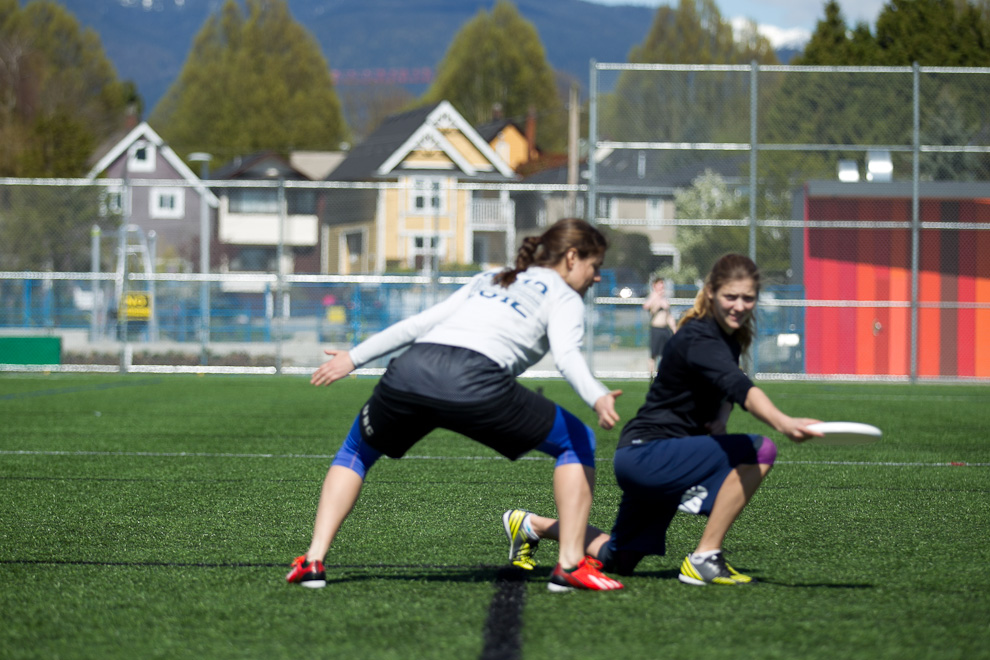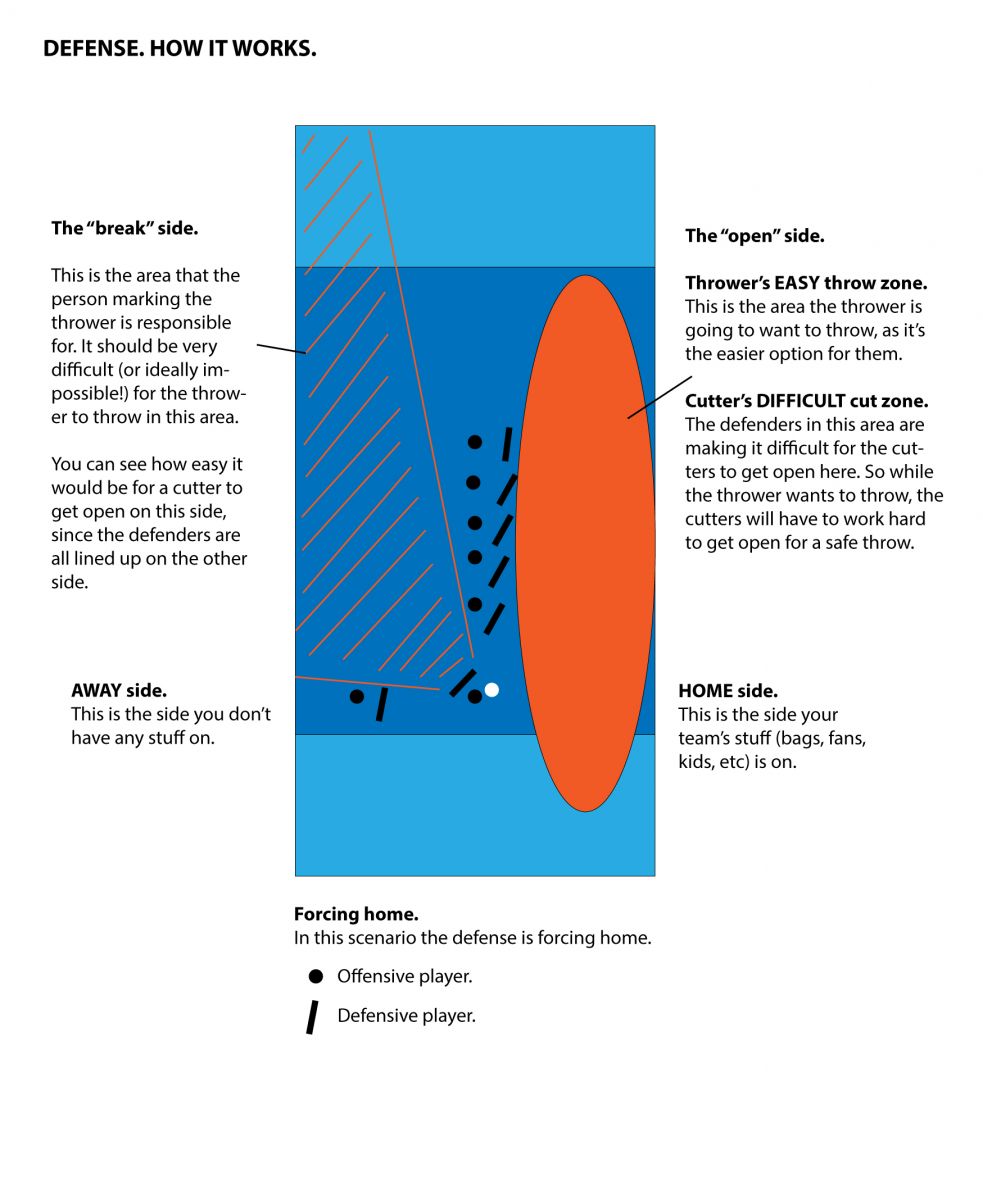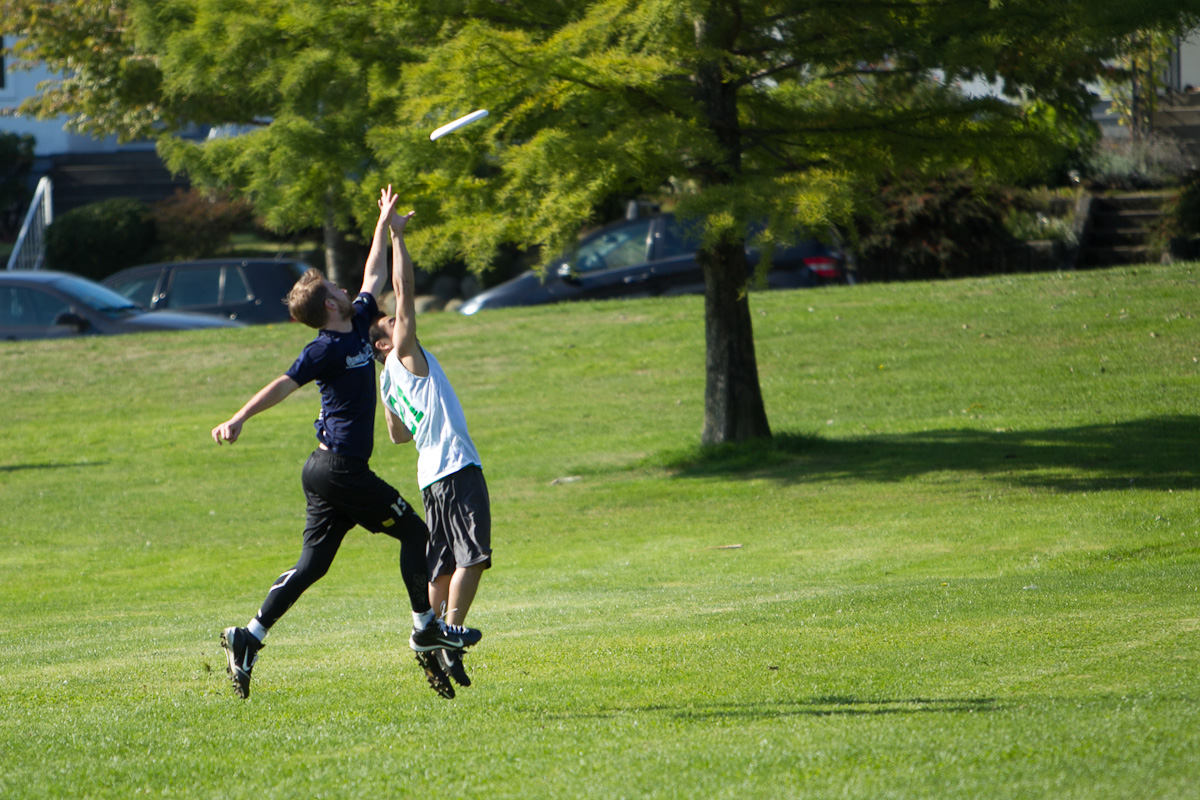.jpg)
Basics of Defense in Ultimate
Defense is played using either one-on-one or zone defense. One-on-one is often referred to as “person-to-person”, or “check defense”
For now, this guide focuses on one-on-one defense. Zone defense guidelines will be added in the future.
- One-on-One Defense Overview
- Marking the thrower (Handler)
- Defending the Cutter
- Defending against a Horizontal Offense
One-on-One Defense Overview
At the beginning of each point when you are on defense, your team will be pulling the disc. The opposing team will line up on the opposite side of the field. Your team will count them off from left to right, to decide who each of you will be covering. This is the person you are marking. This means you will be responsible for trying to guard that person from catching the disc. If they do catch the disc, you’ll also be responsible for “holding the force”, which means trying to force the thrower to throw to one side of the field.
The Force
 The force is the side of the field that your team is encouraging, or forcing, the offense to throw to. Teams articulate this at the beginning of each point, and decide whether they are going to force “home” (where all of your bags and players are) or “away” (the opposite side of the field from your stuff). Things like wind, sun, and strength of throwers on the opposing team are factors which play into the decision on where to force. For example, a beginner team might not have many people who can throw a consistent flick, so forcing to the side that makes them throw flicks is a good strategy.
The force is the side of the field that your team is encouraging, or forcing, the offense to throw to. Teams articulate this at the beginning of each point, and decide whether they are going to force “home” (where all of your bags and players are) or “away” (the opposite side of the field from your stuff). Things like wind, sun, and strength of throwers on the opposing team are factors which play into the decision on where to force. For example, a beginner team might not have many people who can throw a consistent flick, so forcing to the side that makes them throw flicks is a good strategy.
How it works in game
The idea behind the force is that the defensive player marking the thrower (the marker) positions themselves so that there is only an easy throw to one side of the field. This will ensure that teammates defending the cutters (defenders) are at the same time making it difficult for the offensive cutters to get open on the side of the field that the thrower wants to throw to. Therefore, the entire defense comprised of the marker and defenders are either forcing the thrower to make a difficult and risky throw, or forcing the offensive cutters to make difficult and tiring cuts to get open.
To understand the concept, let’s look at what playing defense against a vertical offense looks like. At the end of this section, we’ll show you what it looks like against a horizontal offense. That’s a bit more complicated, so you’ll first need to understand these key concepts first.

Marking the thrower (Handler)
When the person you are defending gets the disc, you have two important jobs: calling out the stall count, and holding the force.
Calling out the stall count.jpg)
The stall count is the time limit a thrower has before the disc must leave their hands. As the marker, it is your job to call out the stall count so that the person you are defending can hear it, and ideally so can the rest of your teammates. To do this:
- Count aloud to 10. As soon as your mark picks up the disc and establishes a pivot foot, you say “Stalling 1!... 2!... 3!...” all the way to 10. Note: You cannot start the stall count until you are at least 3m (10 feet) away from your mark – which means you’ve got to keep moving!
- One second per stall. Each count must be at least one second apart. Throwers can tell you if they think you are counting too fast (by saying "Fast Count"), in which case you will need to go back two counts and resume at a slower rate. Tip: To help set the pace, you can count “Stall 1.. Stall 2.. Stall 3..
- Stalled at 10. Once you say the “t” of ten, the disc needs to be out of the thrower’s hands. If it’s not, you can yell “Stall!” The result is a turnover, so your team would now get the disc.
Holding the force
This means you force your opponent to throw to the side of the field your team agreed upon beforehand (either home or away). Here are the basics of an effective mark:
- Your only goal is to not get broken. Your job is to make sure the thrower throws to the side your team is forcing to. It is okay if they throw the disc; your teammates upfield will be working to make sure the cutter doesn’t catch it.
- Position is key. You want to stand slightly in front of the thrower and to their side, so you are blocking all throws to one side of the field (and leaving the side you are forcing to as an available option).
- Have the correct stance. Keep your arms extended but slightly bent with your hands around waist level. Your legs should be widely planted with knees bent, and your weight should be on your toes so you can move quickly.
- Do not move around the thrower to try to stop them from throwing to the open side, because this will leave the break side available, which is much more disastrous and difficult to recover from. This would mean you were broken and all the cutters will be open because your teammates will be standing on the other side of them. Try to focus on holding the force.
- Disc space. You are allowed to stand one disc space away from the thrower. If you are too close the thrower will yell “Disc Space!” This is simply a warning. You should adjust your position, drop the stall count by two (ie. Stall 3, 4, fast count, …. 3, 4 ..) and you continue playing.
- Play safe. Don't be overly aggressive. It isn't necessary, and it risks injury to the thrower and you.
- Be spirited. Always play with SOTG in mind. Compliment your mark if they do something well, and be friendly!
Now that you have the basics, here are some other things to remember:
- Communicate. When the thrower releases the disc yell “up” so your teammates know the disc is coming. If the force is broken yell “broken” so your teammates know the disc is going to the opposite side of the field and they need to work hard to recover.
- Watch for fakes. Experienced throwers will fake a throw and if the mark bites or moves to block the fake, it gives the thrower an easy opportunity for a break force throw.
Defending the cutter
As essential as marking the thrower is, the system wouldn’t be a system at all without the defenders effectively defending the offensive cutters. As we mentioned previously, the marker on the thrower has the job of making sure they don’t get broken by letting the thrower throw to the break side.
The defenders who are working to defend the cutters have to hold up the other end of the deal by not letting their players get open in the area that is easy for the thrower to throw to. As you read our tips, refer to the video above by watching the cutter and defender instead of the handler and marker.
To effectively defend a cutter:
- Position is key. Guard the offensive cutter by being closest to the open side with about a yard of distance between you and your check.
- Watch your check and the disc. Turn your back to the sideline so that you are able to see both your player and the disc. This helps you see how things are developing and know where to go. This may not always be possible, but always try to look and see where the disc is every few seconds.
- Always be ready. Bend your knees and be on the balls of your feet so you can react quickly.
- Stay in front. Run hard to stay in front of your check so they can’t get open on the open side. If they do get in front of you, run as fast as you can to get close enough so that the thrower is too nervous to attempt the throw.
- Force your check to the break side. Remember which side is the break side for the thrower – that is the side that is much harder for the thrower to throw to. Some find it helps to think about “herding” your player to that side of the field.
- Watch for fakes. Try not to bite on fakes by leaving the open side, as this can leave your team vulnerable.
- Go for the disc. Once the disc is in the air and headed toward your cutter all bets are off – forget your player and go get it. However, it is NOT acceptable to push, bump or run your check over to get the disc. Play smart and safe.
- Start forcing immediately. If your player does get the disc set up the force right away so that the disc doesn’t get thrown to the break side.
- Play safe. Don't be overly aggressive. Don't push to get an advantage. These are examples of flagrant fouls and un-spirited play, which don't belong in Ultimate.
- Be spirited. Always play with SOTG in mind. Compliment your mark if they do something well, and be friendly!
General Strategy and Tips
- Understand where your check wants to go. Assuming your team is holding the force well, you know that your check will want to catch the disc on the open side. They basically have two choices: an in-cut towards the disc, or a deep cut towards the endzone. It can be difficult to protect both of these cuts at the same time, and sometimes it makes sense to choose to protect one cut more than the other.
- Read your check. As the game develops you’ll be able to develop an understanding of what players on the other team like to do, or do often. Is your check faster or taller than you? Then maybe you want to protect the deep cut to the endzone more than the short in cut towards the disc. Does your check like to try and break the mark? Be aware and hold your force strong.
- Read the situation. Think about the conditions of the game. Is it windy and therefor difficult for players to huck the disc? Then protect the in cut more than the deep cut.
- Anticipate. Playing great defense is all about anticipating the next play to gain an advantage on the other team. Try to think of how the next play will develop. For example if you see a strong thrower is about to get the disc, be prepared for the next throw to be a huck, and beat your check to where they want to go.
- Make friends. Saying hello to a check you've been marking all game and/or asking how they're doing is a nice thing to do and a great way to make a new friend!
Defense against a horizontal offense
Horizontal offense is effective because it creates more options for the offense. On the flip side, it creates more threats for the defense to cover.
.jpg)
